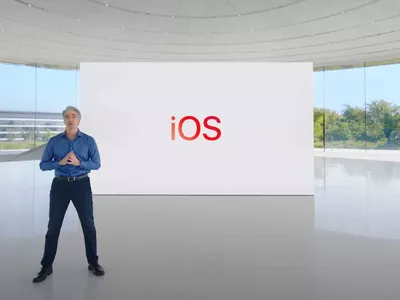
Solved Mac Doesnt Recognize my iPhone 6s | Stellar

Solved: Mac Doesn’t Recognize my iPhone
Summary: Is your Mac not recognizing the iPhone? Learn the 9 ways to fix iPhone not showing up on Mac. You can apply these methods for all iPhone models not recognized by macOS Ventura, Monterey, Catalina, Big Sur, High Sierra and below versions.
You may want to backup iPhone data or transfer favorite photos, music, or videos to Mac. But sometimes your Mac computer doesn’t detect the iPhone when you try to connect it. There are so many complaints such as iPhone not showing up in Finder in Ventura, Monterey, Catalina or Macbook not recognizing iPhone 14. Some also reported an unknown error or a 0xE error when trying to connect iPhone to Mac computer. The situation is frustrating as it prevents you to sync iPhone to macOS and access iPhone data on Mac.
No worries. There are methods, which can fix the issue and let you again access your iPhone on Mac. But, first you should be aware why Mac fails to recognize your iPhone as this helps in troubleshooting the problem.
Why your iPhone not detected by Mac computer?
Mac does not detect your iPhone due to many reasons, such as
- iPhone is not ‘on’ when connected to Mac.
- iPhone is damaged.
- The USB cable or USB port is not working.
- Software updates are pending including iOS, iTunes, and macOS.
- Third-party software conflict wherein 2 programs arecompeting for the same memory, peripheral device etc., on your Mac.
- Firewall or Antivirus software is preventing Mac to recognize iPhone.
- Mac settings don’t allow to view iPhone in Finder.

1. Check your iPhone
Before you connect your iPhone to Mac, make sure the iOS device is unlocked and on the Home screen.
2. Fix USB connection
When Mac computer doesn’t recognize iPhone, first check your USB connection. The USB cable or the port can be faulty. Try to connect iPhone to Mac using another Apple USB 2.0 cable. If that doesn’t work try with the different port. Plus, disconnect other USB devices from Mac except your iPhone.
3. Restart your iPhone
Restarting the iOS device would resolve any issue between your iPhone programs and iTunes. To restart hold volume/side/ top button depending on your iPhone model. Slide the red power off slider on your iPhone. Wait for your iPhone to turn off. After a few seconds, again restart iPhone. Now Mac should recognize your iPhone.
4. Restart your Mac
Restarting Mac clears the cache and memory of your system giving it a fresh start. It also installs pending updates.
5. Update your macOS
When iPhone is not showing up on Mac Finder but you can see it under USB Device Tree, update the macOS to the latest version. Make sure there are no pending software installs.
To check the USB Device Tree on Mac follow the below steps:
- Click on Apple icon followed by About This Mac.
- Click the System Report button.
- Under Hardware, select USB.

Figure: USB Device Tree
- On the right pane, you will see USB Device Tree. If you see your iPhone in the list, then update to the latest macOS.
6. Update iTunes
Older versions of iTunes can create conflict with normal Mac functions. Hence, Apple recommends installing the latest iTunes updates.
To install the latest iTunes, open iTunes. From the menu bar choose Help > Check for Updates and follow the prompts to install the latest version.
Now, check if your Mac recognizes the iPhone or not.
7. Disable antivirus on Mac
One of the reason cited for iPhone not detected by Mac is anti-virus or firewall protection on your system. So disable the antivirus or firewall and then try to connect your iPhone to Mac.
8. Enable iOS device in Mac Preferences
When iPhone is not showing on Mac Finder, check if your Mac Preferences allows to view iOS devices in Finder. To enable iOS device in Finder follow the below steps:
- Go to Finder > Preferences.
- Click on the Sidebar button in Finder Preferences box.
- Check in CDs, DVDs and iOS Devices.

Figure: Finder Preferences
This should fix iPhone not showing up in Finder on Mac.
9. Connect iPhone to a different Mac machine
Try by connecting your iPhone to another Mac. If you receive a message asking to ‘Trust this computer’, click on ‘Trust’ to access your iPhone data on the new computer. Make sure to backup iPhone to avoid data loss situation.
Tip: Have you lost or accidentally deleted Camera Roll, Contacts, Photos Stream, Voice Memos, or more while transferring iPhone data to Mac? No need to worry. Restore the deleted photos, videos, messages, contacts, etc., with the help of an efficient Stellar Data Recovery for iPhone for Mac.
FAQ
1. Can I connect iPhone with Mac wirelessly?
You can sync your Mac and iPhone over the same Wi-Fi network.
- Connect your iPhone to Mac using a USB cable.
- Open Finder on Mac and select your iPhone in the sidebar.
- Click on the General tab.
- Check in Show this iPhone when on Wi-Fi.
- Click Apply.
2. How to fix my iPhone cannot connect to iTunes?
If iPhone is not showing up in iTunes, restart your devices and ensure macOS, iTunes, and iOS are updated. To know more methods, read How fix iPhone unable to connect to iTunes problem.
3. How to connect iPhone to the latest MacBook Pro 2021 that doesn’t have USB A port?
The new MacBook has USB Type-C port. You can use USB-C to Lightning cable to connect iPhone XR, SE, 11, and above to the new MacBook. If you have iPhone X or below use USB-A to Lightning cable.
4. Can I use the methods to fix iPhone 14 not recognized by macOS Ventura?
Yes, you can apply the above methods to fix any iPhone not detected by macOS Ventura, Monterey, Big Sur, Catalina, or below.
5. Will I lose any data when syncing iPhone and Mac?
No, you won’t lose data by syncing iPhone to Mac. Syncing helps to access your iPhone data on Mac anytime from anywhere. However, if you accidentally delete iPhone data, use an iPhone Data Recovery software to restore it.
Wrapping Up
Syncing iOS device to macOS has so many advantages but if Mac is not recognizing your iPhone, you cannot transfer, back up, or access iPhone data on Mac. This post has shared 9 methods to fix the syncing issue of Mac and iPhone. One of them should resolve Mac not detecting your iPhone.
How to Recover lost Calendar on iPhone
Summary: This post shares the best methods to recover lost calendar on iPhone. You can apply these methods on iPhone 14/13/12/11/XS/XR/X/SE/8/7 and below. Also, learn how Stellar Data Recovery for iPhone quickly restores Calendar on your iPhone.
The iPhone Calendar is an indispensable utility for keeping up with your loved ones’ birthdays, anniversaries, appointments, meetings, events, holidays, and other day-to-day activities. Even if you’ve switched over to newer variants like iPhone 15, 14, 13, or 12, you don’t want to part with the old iPhone Calendar settings.
Thus, losing your iPhone Calendar due to deletion, formatting, or other reasons can get annoying.
If you are one of those who has lost Calendar app on iPhone and now looking for ways to restore it back…read this post further.
How to restore calendar on iPhone?
Lost or accidentally deleted Calendar can be recovered by Apple’s backup utilities. However, sometimes backups too may not restore Calendar. Then an iPhone data recovery software is the only solution.
Methods to recover deleted/lost Calendar on iPhone
- Restore from archive of Calendars via iCloud.com
- Restore with iPhone recovery software
- Recover from iCloud or iTunes Backup
1. Restore from archive of Calendars via iCloud.com
Apple creates frequent backup for the Calendars and Reminders apps and saves it to iCloud.com as archives. These archives can be used to restore deleted calendars.
Steps: Restore missing iPhone Calendar via iCloud.com:
- Go to iCloud.com in your browser and log into your account. Click Trust when ‘Trust This Computer’ pop-up appears.
- On the main screen, click on nine-dots and select Data Recovery.

- Next, click Restore Calendars.

- You can see the list of Calendars archive. Click Restore option next to the archive that you want to restore.

- Now confirm your choice to retrieve the Calendar archive. Click Restore.

- Wait for some time for the Restore process to complete.

- Once your required Calendar archive is successfully restored, click OK.

The restored calendars appear on all your Apple devices with Calendars turned on in iCloud settings.
Note: These archives will not contain information like calendar invites. You will have to recreate and reissue the invitations.
2. Restore Calendar on iPhone using iPhone data recovery software
A simpler, more effective and convenient way to recover Calendar app is by using a professional iPhone recovery software, such as Stellar Data Recovery for iPhone . Regardless of the reason for loss – deletion, factory reset, or jailbreak etc., the software can restore the app data on your device.
The DIY tool is safe, easy-to-use, and quick to restore. It thoroughly scans the iOS device (iPhone and iPad), iTunes, and iCloud to recover the lost calendar.
Unlike Apple’s backup solutions (iTunes and iCloud), the software lets you choose and recover specific files, like Calendar or Reminders. This not only speeds up the recovery process but also saves you from receiving thousands of unwanted files.
Stellar Data Recovery for iPhone is also the way out when you don’t have Calendar archives in iCloud.com and unable to retrieve data from iTunes and iCloud.
Steps: Recover deleted/lost Calendar from iPhone
- Download, install and launch Stellar Data Recovery for iPhone on computer.

- On the main scree, select Recover from iPhone option and select the type of data you want to recover. Here, choose Calendar and click Next.
- Connect your iPhone to computer and select that device to proceed forward.

- Click on the Trust/Untrust dialog box to enable sync and data transfer between iPhone/iPad and computer.

- If your iPhone is encrypted, enter your password in the dialog box and click OK.

- Once the scanning is completed, you can see the recoverable data and preview them.

Choose the data you want to restore and click Save to restore them at your desired location.
location.
3. Restore calendar on iPhone from Apple backups
Another method to recover lost Calendar is through Apple backups – iTunes or iCloud. However, this method will work if you earlier saved the backup of your Calendar app.
Note: Deletes and replaces all your current data, be it apps, messages, photos etc., from iPhone.
How to Restore Calendar on iPhone with iCloud backup?
- Go to Settings > General > Reset > Erase all Contents and Settings.

- On Apps & Data screen, tap Restore from iCloud Backup.

- Sign in to your iCloud account.
- Choose the last backup and Restore.

How to restore Calendar with iTunes backup
- Connect iPhone to PC/Mac.
- Launch iTunes.
- Select your iPhone under the Device list and click Summary.
- Click Restore Backup and select the relevant backup date.

- Click Restore and wait for some time for the process to complete.

Conclusion
Apple has tried to address the users’ data loss issues through multiple backup solutions — iTunes, iCloud, and iCloud.com. However, these native backup-based recovery solutions fall short when the user needs to recover specific data; though, you can easily recover lost Calendar from these backup options, but you end up replacing every existing data on your device!
Stellar Data Recovery for iPhone fills in this gap really well. It not only recovers lost or deleted Calendar in situations of jailbreak, water damage, factory reset, and Black Screen of Death, etc., but also recovers specific data that you want.
This feature, along with an exceptionally high data recovery success rate, make the software an essential utility for iPhone users.
FAQ
1.How to bring back the missing Calendar icon on iPhone?
To bring back the missing Calendar icon, you need to re-install it from the App Store. Open App Store, search for the Calendar app and download it again on your iPhone.
2. How to set up Calendar account on iPhone?
Go to the Settings in iPhone > Calendar > Accounts > Add Account.
3. How to add an event on iPhone?
- Open Calendar app and tap + icon in the Day view.
- Enter title, start and end time, invitees, URL, attachment, and so on. Tap Add.
4. How events in Calendar app on iPhone can be viewed?
You can view upcoming events as a list of one day, a week, a month, or a year at a time.
Solved: Photos Disappeared from iPhone Suddenly
‘I noticed that over 500 old photos from iPhone 11 have disappeared and now only the recently shot pictures are showing! I lost almost all of my best memories saved in my phone. I am sure I did not delete them. Where did the pictures disappeared from iPhone? How do I get back photos missing from iPhone? Please help.’
Photos suddenly disappearing from iPhone or random photos missing from Camera Roll or Gallery is a common complaint. Usually, photos get disappeared after iOS update, iPhone reset/restore, or when the device storage is full. You may also lose pictures after installing any new software, or jailbreaking. Sometimes, running an iPhone cleaning software without checking what it is deleting on your iOS device can also result in loss of photos.
The situation is stressful, even more when you don’t have any copies or backup of lost photos.
So how to recover the missing or lost photos on iPhone? This post shares the effective methods to get back the missing photos from Camera Roll, Gallery, or iCloud on your iPhone.
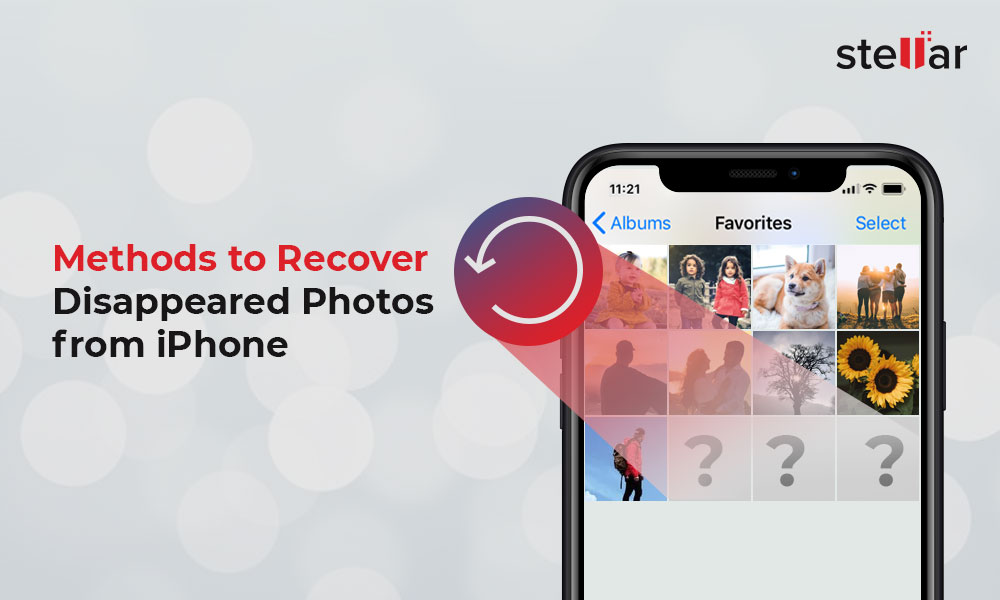
In any such sudden photo loss situation, the best solution is to use a secure photo recovery tool for iPhone that can recover photos lost due to any reason. Besides, there are free methods that might restore disappeared photos from iPhone, which you should try once.
Method 1: Restart your iPhone
If your photos suddenly disappeared from iPhone, first restart the iOS device. Then open the Photo app, Camera Roll, or Photo Stream to see if the missing photos are showing or not.
You can check here the steps to restart your iPhone model .
Method 2: Restore photos from Recently Deleted folder on iPhone
You might have accidentally deleted the photos on iPhone. Check and recover the photos from the ‘Recently Deleted’ folder of your Photos app.
Steps to recover photos on iPhone from ‘Recently Deleted’:
- On your iPhone, click to follow Photos > Albums.
- Scroll down to Utilities and click Recently Deleted.
- Look for your missing photo, tap on it and choose Recover. If there are multiple photos, click on ‘Select’ followed by ‘Recover’.
Note: Photos deleted on iPhone stay in your ‘Recently Deleted’ folder only for 30 days, after which they are permanently removed from the iOS device.
Method 3: Unhide photos on iPhone
Photos disappeared from iPhone can be in the hidden folder in Photos app. Simply, check the Hidden folder on your device and unhide the required photos.
- Open Photos app on iPhone.
- Click on Albums.
- Under Utilities click on Hidden folder. In case you don’t see the ‘Hidden’ folder, go to ‘Settings’ of your iPhone. Click on ‘Photos’ and toggle on ‘Hidden Album’.
- If you see the disappeared photos, select and click on the ‘Share’ button (the arrow icon).
- Next, tap Unhide to move the pictures to their original location on iPhone.
Method 4: Enable iCloud Photos
iCloud Photos store images in iCloud and syncs them to your iPhone, iPad, iCloud.com, iPod touch, Mac, and Apple TV. This means that any changes done to pictures library on one device will show up on your other iOS devices as well. If the photos are disappearing from iPhone only, may be the iCloud Photo is not synced or turned on. So enable iCloud Photos to get back the disappeared pictures on iPhone.
Steps to enable iCloud Photos on iPhone:
- Turn on Wi-Fi of your iPhone.
- On iPhone, navigate to Settings.
- Click on your name and tap iCloud > Photos.
- Toggle on iCloud Photos.
Now check if the missing photos are showing up on iPhone or not.
Method 5: Recover iPhone photos from iTunes backup
If you have created iTunes backup, restore the disappeared photos on iPhone from it. However, this will replace your existing iPhone data with iTunes backup data.
Steps to recover photos from iTunes:
- Connect your iPhone to computer.
- Launch iTunes.
- Select your iPhone under the device list and click on Summary.
- Click Restore Backup.
- In the Restore from Backup box, select the backup date that contains your photos.
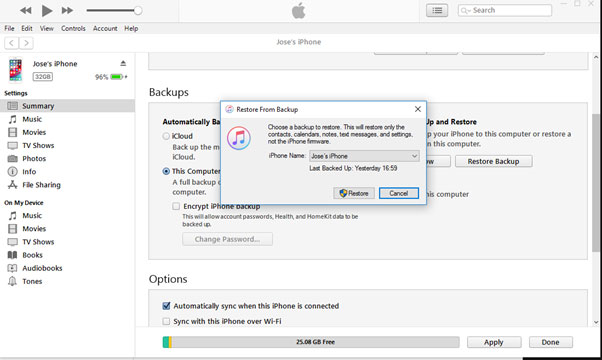
- Click Restore. Wait until the process finishes and your iPhone restarts. All your disappeared photos will be recovered on iPhone.
Method 6: Restore photos from iCloud Backup
You can restore the previous iCloud backup that has the missing photos. However, like iTunes, this method will also replace the current data on your iPhone.
Steps to recover disappeared photos from iCloud:
- On your iPhone, go to Settings > General > Reset.
- Click on Erase all Contents and Settings. In the dialog box, choose Erase Now.
- On the Apps & Data screen, click Restore from iCloud Backup. Enter your Apple ID. In case you have forgot your Apple ID, click here to know how to recover it.
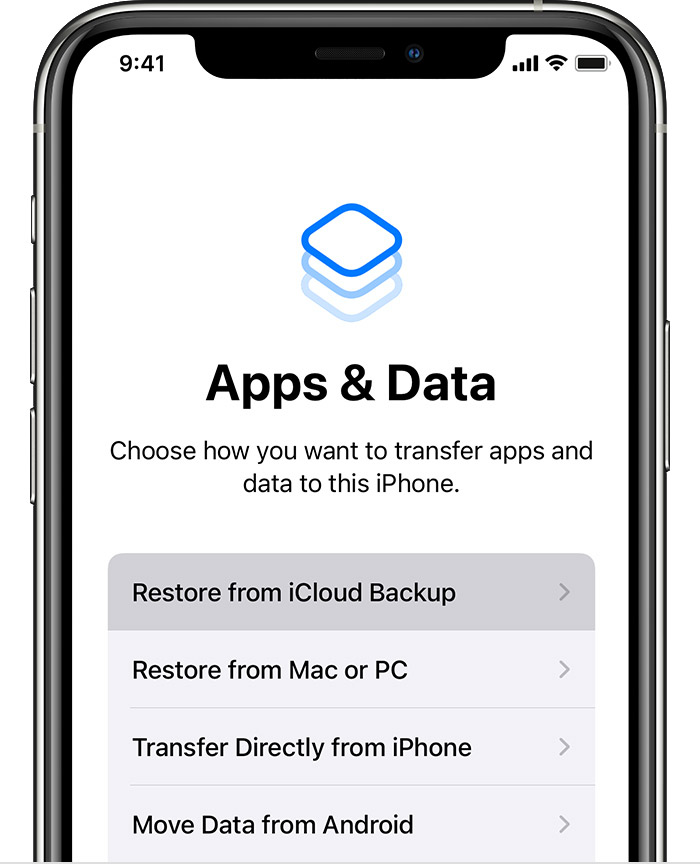
- Select the recent backup and click Restore. The lost photos should now appear on iPhone.
Method 7: Recover lost photos with an iPhone data recovery software
The advanced iPhone recovery software — Stellar Data Recovery for iPhone, can restore photos lost, deleted, or missing due to any reason. Whether your photos disappeared from iPhone after update, due to low storage, or any other reason, the software can recover in all situations.
The biggest advantage of using the software is that it doesn’t remove your existing iPhone data. Further, the software shows the preview of the recoverable photos. Hence, its easy to select and recover only the required disappeared pictures from Camera Roll, iCloud Photo Library, Gallery, or those shared on chat messages, etc. Stellar Data Recovery for iPhone is compatible with the latest iPhone 14/13/12/11, iPad, and iPod touch. The software supports recovery from the latest iOS 16 and older versions.
Quick steps to recover disappeared photos from iPhone:
- Download Stellar Data Recovery for iPhone on PC or Mac.
- Connect your iPhone to computer.
- Launch the software and select Recover from iPhone option from the left panel.

- Select the Camera Roll or Photo Stream from where the photos have disappeared and click Next to the start the scanning process.
- Now preview the recoverable photos, select them, and click Save to restore on iPhone or computer.

Note: You can also recover the lost photos from backup by choosing Recover from iCloud backup or Recover from iTunes backup , options in the software.
Conclusion
When you find suddenly photos disappearing from iPhone try any of the above 7 methods to get back the lost pictures. However, of all we recommend solutions Stellar Data Recovery for iPhone software is quick and easy to use. It is also of great help when you don’t want to recover from iCloud or iTunes backup that removes the existing data on iPhone.
Apple will delete your photos in July. Here’s what you should do
Apple has recently announced that it will permanently delete photos from its users’ ‘My Photo Stream’ this month. This news has come as a surprise to the Apple community, as users struggle to understand the implications of this announcement and what necessary precautions can be taken. In this blog post, we will get into the details of this new move by Apple, explore the reasons behind it, and provide tips on how iPhone/iPad/Mac users can safeguard their precious photos.
The Announcement
_”_My Photo Stream is scheduled to be shut down on July 26, 2023. As part of this transition, new photo uploads to My Photo Stream from your devices will stop one month before, on June 26, 2023.
The photos in My Photo Stream are already stored on at least one of your devices, so as long as you have the device with your originals, you won’t lose any photos as part of this process. If a photo you want isn’t already in your Library on a particular iPhone, iPad, or Mac, make sure that you save it to your Library on that device…” Read more
What is Apple’s My Photo Stream?
My Photo Stream, launched in 2011, was designed to sync photos across multiple Apple devices such as iPhone, iPad, or Mac.
This feature automatically stores your most recent pictures (up to 1000) for approx. 30 days so you can view and download them easily from other Apple devices. After this period, photos are removed from My Photo Stream but remain in your device’s Photos app. However, this only shows photos and not your live images or videos.
How to Protect Your ‘My Photo Stream’ Pictures?
Apple, known for its commitment to user privacy and data security, has recommended several preventive measures to mitigate the risk of losing any important photo due to this update.
1. Move My Photo Stream images to your Library
Even if the pictures in My Photo Stream are already there on at least one of your Apple devices, you must save these pictures to your Photo Library to avoid losing them**.** Here’s how to copy My Photo Stream pictures to your Photo Library:
On your iPhone, iPad, or iPod Touch:
- Open the Photos app and tap Albums.
- Tap on My Photo Stream > Select.
- Select all the photos you want to save, then tap the Share button > Save Image.
On your Mac:
- Open the Photos app and then open the My Photo Stream
- Select the photos you want to save which aren’t currently in your photo library.
- Drag and drop them from the My Photo Stream album into your Library.
2. Move to iCloud Photos
To preserve your My Photo Stream images in their original and high-resolution version, you can transfer them to iCloud Photos.
If you already have an iCloud account, just enable iCloud Photos to automatically upload & sync every photo and video you capture on the device, making them accessible from anywhere.
To use the iCloud Photos service, you will require the following:
- iPhone running iOS 8.3 or later version.
- iPad with iPadOS 8.3 or later version.
- Mac running OS X Yosemite or later version.
How to set up iCloud Photos on your iPhone, iPad, or iPod touch?
- On your iPhone, iPad, or iPod touch, go to Settings.
- Next, click on [Your Name] > iCloud.
- Tap on Photos and do the following:
For iOS 16, iPadOS 16, or later versions: Toggle on the ‘Sync this [device]‘ option.
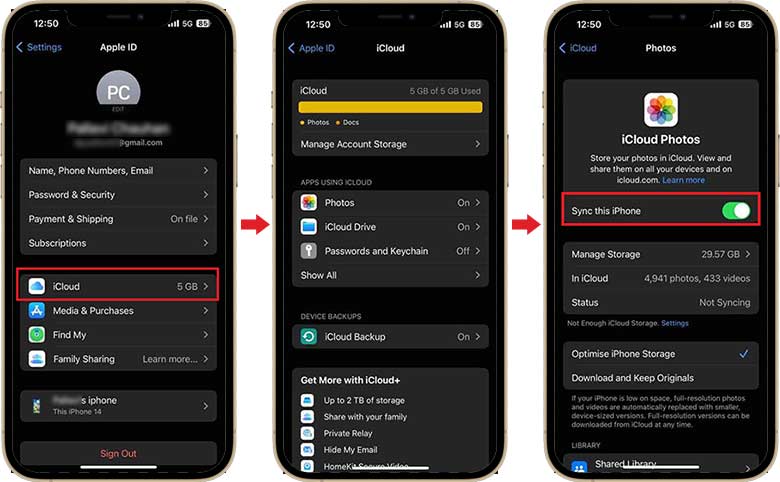
For iOS 15, iPadOS 15, or earlier versions: Turn on the iCloud Photos
How to set up iCloud Photos on your Mac?
- On your Mac, go to Apple Menu and click on System Preferences.
- Click Apple ID and then select iCloud in the sidebar.
- Now, select Photos and turn on the switch next to Sync this Mac.
**
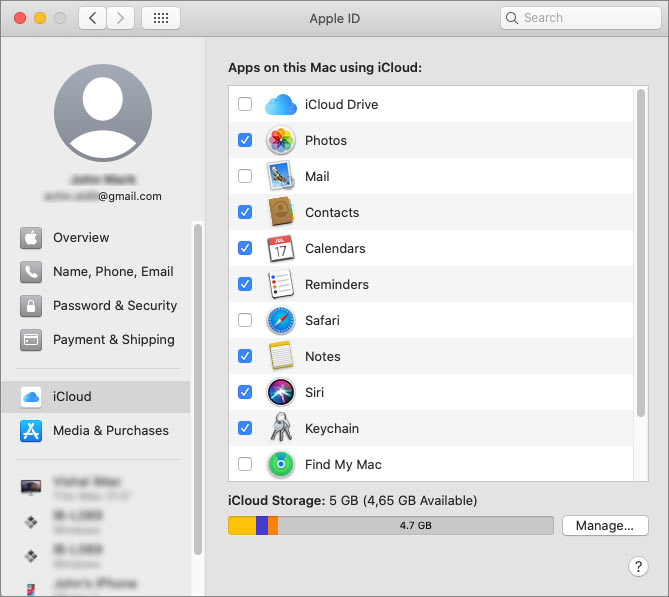
**
Don’t want to use iCloud Photos?
While iCloud Photos is a convenient option for many Apple users, it’s important to acknowledge that it is not the best fit for everyone. Limited free storage of 5GB or lack of cross-platform compatibility can compel Apple users to look for other alternatives.
Storage options, such as Google Photos, Microsoft OneDrive, Dropbox, external hard drives, etc., are available to ensure your iPhone Photos are safe and easily accessible.
The Bottom Line
Apple’s announcement of the potential discontinuation of My Photo Stream has understandably caused worry among its users. While a specific reason for this action remains undisclosed, they are actively addressing the issue to prevent data loss. In the meantime, iPhone users must take precautionary measures to safeguard their photos. They can simply move the My Photo Stream images to the Photo Library, iCloud Photos, or other backup folders.
Also read:
- [Updated] 2024 Approved Mastering Multitasking Using OBS Studio for Dynamic Streaming
- [Updated] Unlocking Your Creative Potential Without Spending
- Cutting-Edge Capture 8 Latency-Free Tools
- How To Recover Lost Data from Apple iPhone X? | Dr.fone
- How to Soft Reset Motorola Edge 40 Neo phone? | Dr.fone
- How To Transfer Data From Apple iPhone 14 To Other iPhone 11 Pro devices? | Dr.fone
- How to Update Apple iPhone 12 Pro Max without Losing Data? | Dr.fone
- In 2024, Full Guide on Mirroring Your Honor 100 Pro to Your PC/Mac | Dr.fone
- In 2024, How To Enable USB Debugging on a Locked Infinix Note 30 Phone
- Quick Guide Off Instagram's IGTV for 2024
- The way to get back lost call history from Honor X50
- Things You Dont Know About Vivo Y27 5G Reset Code | Dr.fone
- Three Solutions to Hard Reset Oppo A56s 5G? | Dr.fone
- Top 5 Advantages: Why Paid Mobile Gaming Is Superior
- Topo 5 De Los Más Efectivos Software Libre Para Restaurar Archivos en Windows 11
- Unlock android phone if you don't have Narzo 60 Pro 5G fingerprint
- Updated In 2024, The Professionals Method for Removing Unwanted Sounds From Media Projects Using Premiere Pro
- Title: Solved Mac Doesnt Recognize my iPhone 6s | Stellar
- Author: Ian
- Created at : 2025-01-19 23:25:17
- Updated at : 2025-01-21 17:42:49
- Link: https://techidaily.com/solved-mac-doesnt-recognize-my-iphone-6s-stellar-by-stellar-data-recovery-ios-iphone-data-recovery/
- License: This work is licensed under CC BY-NC-SA 4.0.




